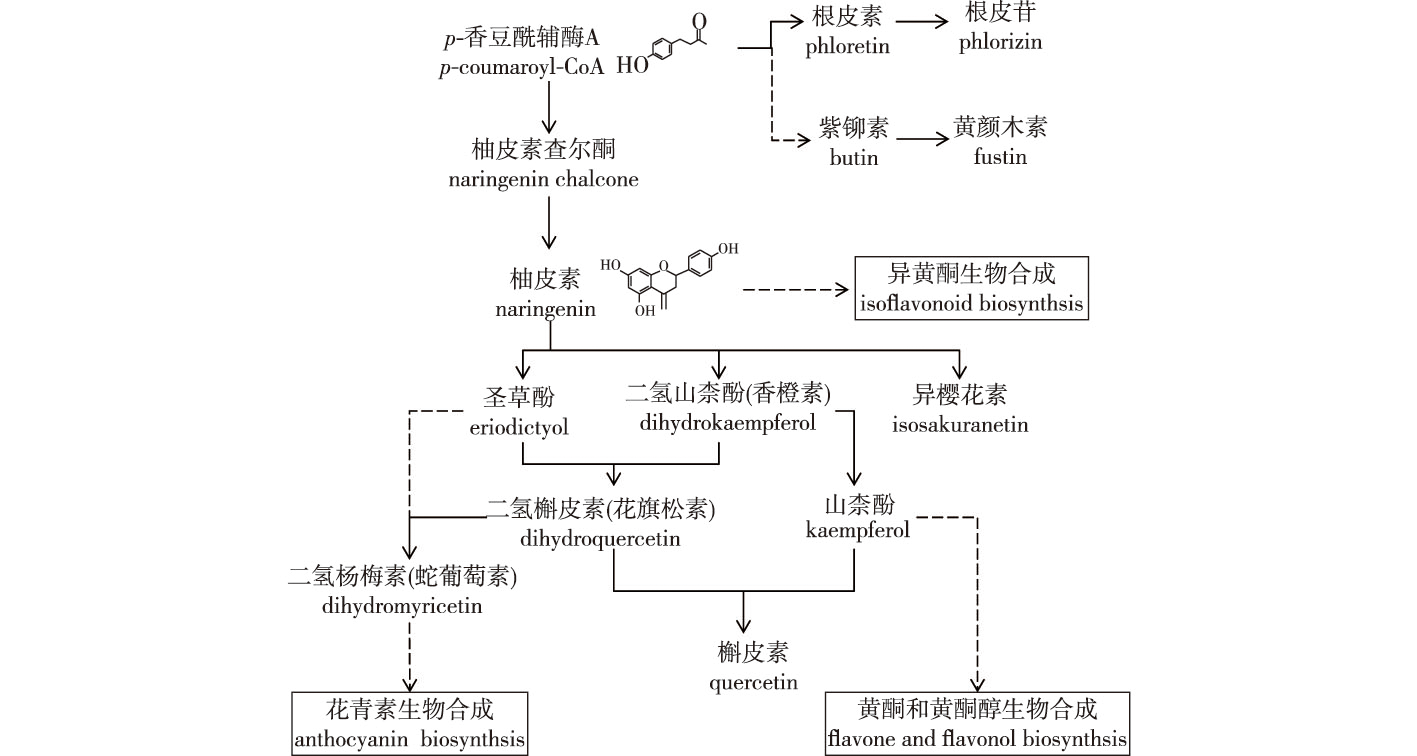 PDF(1817 KB)
PDF(1817 KB)


油松抗性相关激素与代谢物对油松毛虫取食与剪叶刺激的响应
赵亚楠, 孙天骅, 王利峰, 许强, 刘军侠, 高宝嘉, 周国娜
南京林业大学学报(自然科学版) ›› 2024, Vol. 48 ›› Issue (1) : 219-226.
 PDF(1817 KB)
PDF(1817 KB)
 PDF(1817 KB)
PDF(1817 KB)
油松抗性相关激素与代谢物对油松毛虫取食与剪叶刺激的响应
Plant hormones and metabolites response to feeding stimulation by pine caterpillar (Dendrolimus tabulaeformis) and leaf clipping control in Chinese pine (Pinus tabuliformis)
【目的】通过对油松毛虫(Dendrolimus tabulaeformis)取食刺激后的油松(Pinus tabuliformis)针叶进行分析,明确针叶树响应昆虫取食后树体内化合物的代谢途径变化,为油松的生长与保护提供参考。【方法】在河北省承德市平泉市黄土梁子林场选取生长状况良好的油松纯林,对距地面高度一致的4个方向针叶进行10头油松毛虫取食(feeding stimulation,FS)与剪叶刺激(leaf clipping control, LCC)处理,摘取取食点或剪叶点下方3 cm的油松针叶,对照组不做任何处理(记为处理0 h,CK),取完整松针,对不同处理后0、2 与8 h的松针进行代谢组分析和总类黄酮的验证,对0、0.5、1.0、1.5、2.0、4.0、6.0和8.0 h的松针进行茉莉酸(JA)、水杨酸(SA)、生长素(IAA)与脱落酸(ABA)相关植物激素含量的测定。【结果】通过代谢组学分析,FS处理后2.0 h与LCC处理后2.0 h的差异积累代谢物(different accumulated metabolites,DAMs)主要注释和富集的前3条通路为类黄酮生物合成、氨基酸合成代谢、精氨酸和脯氨酸代谢;FS处理后8.0 h与LCC处理后8.0 h的DAMs主要注释和富集的前3条通路为类黄酮生物合成、亚油酸生物合成、黄酮和黄酮醇的生物合成。因此,与LCC处理相比,FS处理可以显著诱导油松针叶取食点处类黄酮类物质的表达上调。植物激素JA、IAA表现出与代谢组中相应物质一致的表达趋势。相关性分析显示,JA与SA、JA与IAA、IAA与ABA之间呈显著正相关关系(P<0.05),SA与IAA和ABA之间呈负相关关系。【结论】类黄酮途径是参与油松抗性形成的主要代谢途径之一,单纯的机械损伤不会引起JA、IAA与ABA的显著差异,且JA、IAA、ABA参与油松抗性形成与生长发育过程。
【Objective】This experiment was conducted with the aim of defining changes in metabolic pathways in response to mandibulate insect feeding and providing references for the growth and protection of Chinese pine (Pinus tabuliformis).【Method】Pure P. tabuliformis forest in good growth status in Huangtuliangzi Forest Farm of Pingquan City, Chengde City, Hebei Province was the experimental field. Branches with consistent branch length and height above the ground in four directions were stimulated by ten pine caterpillars (Dendrolimus tabulaeformis) for feeding stimulation and leaf clipping control for mechanical damage. The pine needles were collected 3 cm below the chewing or cutting sites. The CK group received no treatment (0 h, recorded as 0 h), and 10 intact pine needles were collected. Metabolome and total flavonoid contents were measured in the needles at 0, 2 and 8 h after the different treatment modes. The plant hormones JA, SA, IAA and ABA were measured using needles at 0, 0.5, 1.0, 1.5, 2.0, 4.0, 6.0, and 8.0 h after different treatments.【Result】Analysis of metabolomics showed that the top three pathways mainly annotated and enriched for DAMs compared to 2.0 h after FS and LCC are flavonoid biosynthesis, amino acid metabolism, and arginine and proline metabolism; the top three pathways mainly annotated and enriched for DAMs compared to 8.0 h after FS and LCC are flavonoid biosynthesis, linoleic acid metabolism, and flavonoid and flavonol biosynthesis. Thus, D. tabulaeformis feeding stimulation can significantly induce the upregulation of flavonoid expression at the chewing sites of needles when compared to the leaf clipping control. The plant hormones, JA and IAA, showed expression trends consistent with those of the corresponding substances in the metabolome. A significant positive correlation between JA and SA, JA and IAA and IAA and ABA (P< 0.05) was observed. 【Conclusion】Thus, the flavonoid pathway is one of the main pathways involved in resistant formation in conifers. Simple damage mechanisms did not induce significant differences in JA, IAA and ABA; thus, JA, IAA and ABA are involved in the development of resistance and growth during biotic stress.

油松 / 油松毛虫 / 取食刺激 / 诱导抗性 / 植物激素 / 类黄酮途径 / 代谢组学
Pinus tabuliformis / Dendrolimus tabulaeformis / feeding stimulation / induced resistant / plant hormone / flavonoid pathway / metabolome
| [1] |
窦宏双, 梁晓, 陈青, 等. 二斑叶螨为害前后抗、感木薯转录组分析及水杨酸、茉莉酸途径差异表达基因验证[J]. 热带作物学报, 2021, 42(11): 3146-3155.
|
| [2] |
黄双杰, 曹梦珍, 陈凌芝, 等. 氮素胁迫条件下茶树根系发育及生长素的响应[J]. 江苏农业学报, 2023, 39(3):814-821.
|
| [3] |
|
| [4] |
|
| [5] |
赵利, 钞建宾, 郭捷, 等. 基于代谢组学技术的植物抗病相关代谢物研究进展[J]. 西北植物学报, 2021, 41(6):1071-1078.
|
| [6] |
|
| [7] |
张佳松. 甘蔗响应黏虫取食的代谢组学分析[D]. 福州: 福建农林大学, 2020.
|
| [8] |
张强, 周鹏, 刘昌来, 等. NaCl处理下全缘冬青和红果冬青根系的转录组活性比较[J]. 南京林业大学学报(自然科学版), 2022, 46(3): 99-108.
|
| [9] |
张斌, 高宝嘉, 刘洋. 剪叶和取食刺激对油松体内几种防御酶的活性及其动态的影响[J]. 生态科学, 2017, 36(1):118-122.
|
| [10] |
石媛媛, 冯金周, 于连海, 等. 昆虫取食和剪叶刺激对油松针叶内部分防御物质的诱导效应[J]. 河北农业大学学报, 2017, 40(1):81-86.
|
| [11] |
王银翠, 周国娜, 张斌, 等. 油松毛虫取食和剪叶刺激胁迫下油松的蛋白质表达差异分析[J]. 林业科学, 2016, 52(8):68-75.
|
| [12] |
秦世杰, 祁金玉, 刘仁军, 等. 自然状态下油松感染松材线虫后的生理响应[J]. 沈阳农业大学学报, 2021, 52(5):625-632.
|
| [13] |
|
| [14] |
|
| [15] |
|
| [16] |
|
| [17] |
徐展宏, 朱莹, 金慧颖, 等. 不同叶色青钱柳叶片色素、多酚含量及光合特性的差异[J]. 南京林业大学学报(自然科学版), 2022, 46(2):103-110.
|
| [18] |
|
| [19] |
|
| [20] |
|
| [21] |
王伟伟. 茶树对茶尺蠖的抗性评价及其抗性机制研究[D]. 武汉: 华中农业大学, 2018.
|
| [22] |
|
| [23] |
|
| [24] |
李永华, 肖能文, 刘勇波. 植物防御中茉莉酸信号通路抑制与终止的作用机制[J]. 植物保护学报, 2021, 48(3):563-569.
|
| [25] |
邓苗苗, 郭晓黎. 植物响应寄生线虫侵染机制的研究进展[J]. 生物技术通报, 2021, 37(7):25-34.
|
| [26] |
叶德友, 漆永红, 李敏权. 植物与线虫互作的信号传导及调控机制研究进展[J]. 草业学报, 2016, 25(10):191-201.
|
| [27] |
张瑾, 邢玉娴, 韩涛, 等. 茶树诱导抗虫性的研究进展[J]. 昆虫学报, 2022, 65(3):399-408.
|
| [28] |
|
| [29] |
|
| [30] |
丁旭, 黄茜, 邓沁宇, 等. 脱落酸在植物抗虫性中的作用研究进展[J]. 环境昆虫学报, 2019, 41(4):808-813.
|
| [31] |
张吉玲, 李明阳, 李勇, 等. 机械损伤处理杉木无性系萌蘖及内源激素含量差异[J]. 南京林业大学学报(自然科学版), 2021, 45(2): 153-158.
|
| [32] |
|
| [33] |
岳喜良, 秦健, 洑香香, 等. 氮素水平对青钱柳叶片主要次生代谢物含量和抗氧化能力的影响[J]. 南京林业大学学报(自然科学版), 2020, 44(2): 35-42.
|
/
| 〈 |
|
〉 |